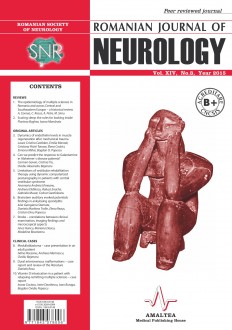SELECT ISSUE

Indexed

| |

|
|
|
| |
|
|
|

|
|
|
|
|
|
| |
|
|
HIGHLIGHTS
National Awards “Science and Research”
NEW! RJN has announced the annually National Award for "Science and Research" for the best scientific articles published throughout the year in the official journal.
Read the Recommendations for the Conduct, Reporting, Editing, and Publication of Scholarly work in Medical Journals.
The published medical research literature is a global public good. Medical journal editors have a social responsibility to promote global health by publishing, whenever possible, research that furthers health worldwide.
STROKE – CORRELATIONS BETWEEN CLINICAL EXAMINATION, IMAGING FINDINGS AND MICROSCOPICAL ASPECTS
Anca Hancu, Mariana Deacu and Madalina Bosoteanu
ABSTRACT
Stroke is the most frequent cause of disability among the neurologic diseases of the adult. In the last two decades, the extraordinary development of brain imaging techniques allows the rapid recognition of normal, ischemic, infarction or hemorrhagic brain tissue. The term cerebrovascular disease designates any abnormality of the brain resulting from a pathological process of the blood vessels, including occlusion by embolus or thrombus, rupture of a vessel, an altered permeability of the vessel wall, or increased viscosity or other changes in quality of the blood flowing through the cerebral vessels. The clinical, imagistic and histological correlations in the study of arteriosclerosis are very important due to the fact that cardiovascular disease and stroke are the main causes of death in developped countries. Our study consists of a group of 36 patients admitted in the Neurology department of Constanta County Emergency Hospital in the first six months of 2012 with the diagnosis of acute stroke, which died within the first 5 days from admission. The studied group was divided into four subgroups, according to the CT scan findings and clinical examination on admission and the autopsy results. In the sudden death cases that had no acute lesions on the brain CT on admission, histological examination revealed the diagnosis. In all cases, histological examination included in showed atherosclerotic modifications of cerebral and peripheral vessels (the circle of Willis arteries, coronary arteries, aorta and renal arteries).
Keywords: atherosclerosis, CT scan, histological examination, stroke
Full text | PDF
